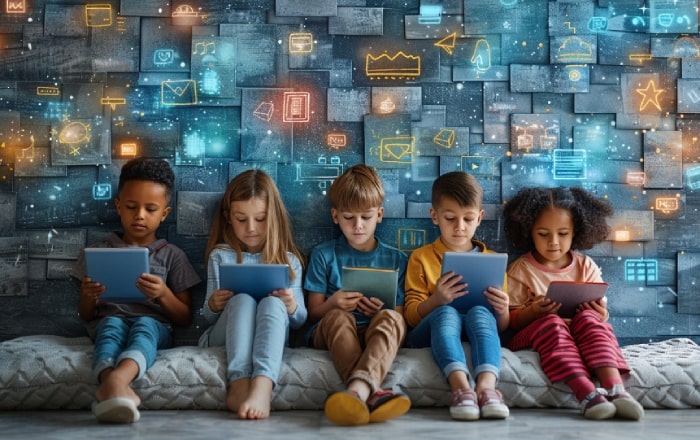Sep 16 2024
Game-Based Learning in European K-12 Education: The Role of the Lift-Shift-Uplift Strategy

Director of Business Development

Sep 16 2024

Director of Business Development

The traditional classroom model is increasingly falling short in addressing the diverse needs of today’s students. As European K-12 educational systems face mounting pressure to boost student engagement and academic outcomes, game-based learning is emerging as a powerful solution. A recent study by Gamification Hub reveals that students participating in game-based learning programs demonstrate up to a 60% improvement in engagement and a ninefold increase in knowledge retention when compared to traditional training methods. This compelling evidence underscores a critical need for educational innovation.
In response to this need, game-based learning transforms mundane lessons into interactive, dynamic experiences by incorporating game elements such as scoring, rewards, and immersive scenarios into the learning process. This innovative approach not only makes learning more engaging but also supports deeper comprehension and long-term retention.
This blog will explore how the “Lift-Shift-Uplift” strategy can enhance game-based learning in European K-12 schools. We’ll discuss how to elevate existing content, migrate to advanced platforms, and continuously improve these gamified solutions to meet your evolving educational needs. Let’s dive into how this strategic approach can reshape your learning landscape and drive your educational success.
Game-Based Learning (GBL) is an educational approach that incorporates game design elements and principles into the learning process to enhance engagement, motivation, and educational outcomes. At its core, GBL involves integrating games—whether digital, physical, or a hybrid of both—as tools to teach and reinforce educational concepts.
In game-based learning, content is delivered through structured activities that mimic game mechanics, such as point scoring, leaderboards, challenges, and rewards. This approach leverages the inherent motivational qualities of games, such as competition, collaboration, and achievement, to make learning experiences more interactive and enjoyable. By integrating game elements and educational objectives into the learning process, GBL transforms traditional learning into a dynamic, immersive experience. GBL also encourages active participation, critical thinking, and problem-solving skills while making the learning process more engaging and effective.
By creating an environment where learning feels like play, educators can foster a more dynamic and effective educational experience.
In the current evolving educational landscape, simply integrating game-based learning (GBL) isn’t enough. To truly transform the learning experience, schools and institutions need a strategic approach. Enter the “Lift-Shift-Uplift” strategy—a proven framework to maximise the impact of GBL in European K-12 education.
The first step in the Lift-Shift-Uplift strategy is to “lift” your current educational content with gamification elements. This involves transforming traditional lessons into engaging game-like experiences.
How It Works:
Once you’ve gamified your content, the next step is to “shift” it to advanced platforms that support these enhancements. Migrating to these new, interactive tools allows you to fully leverage gamified elements and offer a richer learning experience.
How It Works:
The final step is to “uplift” your game-based learning solutions by continually refining and enhancing them. This involves using feedback to make iterative improvements and incorporating new technologies to remain at the forefront of educational innovation.
How It Works:
When schools and educational institutions face the hurdles of implementing game-based learning, MRCC EdTech steps in as your reliable partner to overcome these challenges head-on. With our platform migration service and tailored content solutions, MRCC EdTech ensures a seamless transition to a gamified learning environment, making the most of the latest technology while staying within your budget. In the following, we’ve listed the potential challenges of implementing game-based learning and how MRCC EdTech solves them.
Problem: Many schools struggle with outdated technology and limited infrastructure, making it difficult to support game-based learning.
MRCC EdTech’s Solution: Our platform migration service is designed to upgrade and optimise your existing systems, ensuring that they’re fully capable of supporting advanced game-based learning solutions. We assess your current technology landscape, identify gaps, then migrate your content to platforms that are robust, scalable, and user-friendly. Whether you’re dealing with outdated hardware or limited software capabilities, MRCC EdTech ensures that your school’s technology is up to the task, without disrupting the learning process.
Problem: Educators and administrators often resist the shift from traditional methods to game-based learning due to unfamiliarity or concerns about its educational value.
MRCC EdTech’s Solution: We don’t just provide the tools; we empower your educators to use them effectively. MRCC EdTech offers comprehensive professional development content solutions that train teachers on integrating gamified solutions into their teaching strategies. Our training is hands-on and practical, helping educators see the immediate benefits and feel confident in their ability to use these new tools. By addressing concerns directly and offering ongoing support, we help schools embrace game-based learning with enthusiasm.
Problem: The cost of implementing game-based learning can be prohibitive, especially when it involves significant investments in new technology and content development.
MRCC EdTech’s Solution: We understand budget constraints and work to provide cost-effective solutions that deliver maximum value. Our content solutions are flexible and can be tailored to fit within your budget while still achieving your educational goals. We also offer scalable gamified content that can be integrated into your existing curriculum, reducing the need for expensive overhauls. Plus, our platform migration service is designed to streamline your costs by consolidating resources and optimising existing technology, ensuring that you get the most out of your investment.
Problem: Integrating game-based learning into the curriculum can be complex, requiring alignment with educational standards and learning objectives.
MRCC EdTech’s Solution: Our team of experts works closely with your school to develop gamified content that aligns perfectly with your curriculum. We take the time to understand your educational goals, then create custom solutions that meet both your standards and your students’ needs. With MRCC EdTech, integrating game-based learning into your curriculum becomes a smooth, straightforward process, ensuring that the educational value is preserved while enhancing student engagement.
MRCC EdTech: Your Trusted Partner for Gamified Learning Solutions
MRCC EdTech doesn’t just hand over solutions; we stand by you through every step of the implementation process. From initial planning and technology assessments to training and ongoing support, our team is dedicated to making your transition to game-based learning as smooth as possible. We ensure that all potential challenges are addressed proactively, allowing your institution to unlock the full potential of gamified education without any setbacks.
Ready to incorporate gamification in online courses?
With MRCC EdTech’s platform migration service and tailored content solutions, we solve the challenges of implementing game-based learning into education head-on, empowering your school to embrace the future of education confidently. Contact MRCC EdTech today to discover how our platform migration solutions can help you create a dynamic and engaging learning environment. Let’s transform education together.

Leave A Reply
Your email address will not be published. Required fields are marked *